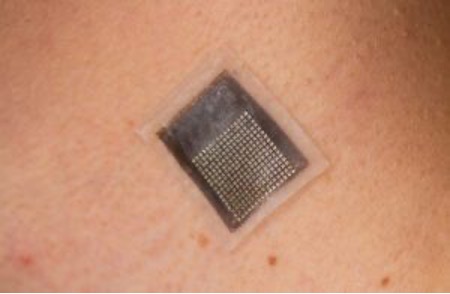Wearable ultrasound researchers report breakthrough in deep tissue monitoring
May 5, 2023
Source: drugdu
 536
536

This wearable ultrasound device for monitoring tissue stiffness measures 23 mm x 20 mm x 0.8 mm.
[Photo courtesy of University of California San Diego]
Wearable ultrasound researchers have developed a stretchable ultrasonic array for serial, noninvasive, 3-D tissue imaging with a penetration depth of up to 4 cm.
The latest device out of Sheng Xu’s lab at the University of California San Diego (UCSD) is able to frequently evaluate the stiffness of human tissue. It could be used to measure the progression of cancer, to monitor muscles, tendons and ligaments, and assess the effectiveness of liver and cardiovascular treatments.
Xu is commercializing the technology through a UCSD spinoff called Softsonics.
“We integrated an array of ultrasound elements into a soft elastomer matrix and used wavy serpentine stretchable electrodes to connect these elements, enabling the device to conform to human skin for serial assessment of tissue stiffness,” study coauthor Hongjie Hu, a postdoctoral researcher in the Xu group, said in a news release.
The study was published this week in Nature Biomedical Engineering.
Measuring stiffness can offer information about a patient with cancer, which causes cells to stiffen, and patients with musculoskeletal disorders such as tendonitis, tennis elbow and carpal tunnel syndrome.
Monitoring tissue stiffness can also help doctors diagnose and track myocardial ischemia. Arterial wall elasticity changes offer early warning signs, allowing for timely interventions.
“This new wave of wearable ultrasound technology is driving a transformation in the healthcare monitoring field, improving patient outcomes, reducing healthcare costs and promoting the widespread adoption of point-of-care diagnosis,” said study co-author Yuxiang Ma, a visiting student in the Xu group. “As this technology continues to develop, it is likely that we will see even more significant advances in the field of medical imaging and healthcare monitoring.”
How the wearable ultrasound device works
The team explained how their wearable ultrasound device delivers elastographic imaging validated with magnetic resonance elastography. The device — which measures 23 mm x 20 mm x 0.8 mm — sticks to the skin and acoustically couples with it.
“We choose 3 MHz as the center frequency for the ultrasound transducer,” said Hu. “Since the higher the center frequency, the higher the spatial resolution, but the stronger the attenuation of the ultrasound wave in tissues, 3 MHz satisfies the requirements for both high spatial resolution and superb tissue penetration.”
The team found a distance of 800 μm between the centers of adjacent elements was “adequate for producing high-quality images, minimizing interference from neighboring elements and giving the entire device its good stretchability,” said Xiaoxiang Gao, another postdoctoral researcher in the Xu group.
The device delivers a spatial resolution of 0.5 mm with a maximum signal-to-noise ratio of 28.4 dB and contrast resolution of 1.74 dB.
The team developed a low-temperature bonding approach to avoid thermal damage from traditional fabrication methods. Instead of solder paste, the team use conductive epoxy for room-temperature bonding, Hu said.
“In addition, we replaced the single plane wave transmission mode with coherent plane-wave compounding mode, which provides more energy to boost the signal intensity throughout the entire sample,” Hu said. “Using these strategies, we improve the sensitivity of the device to make it perform well in capturing those weak signals from scattering particles.”
Further improvements could increase the device’s diagnostic capabilities, the team said.
Reference: https://www.medicaldesignandoutsourcing.com/wearable-ultrasound-researchers-deep-tissue-monitoring-breakthrough/
By editorRead more on
- CoreMedik Unlocks Dual Certifications for Implantation & Intervention of Artificial Heart December 25, 2025
- First in over 70 years! New drug for schizophrenia approved in China December 25, 2025
- Is the “anti-aging drug” a scientific breakthrough or a capital game? December 25, 2025
- Wegovy oral tablets receive FDA approval, ushering in the “dual-dosage era” for GLP-1 weight-loss drugs December 25, 2025
- The leading medical device company’s new venture is aiming for an IPO! December 25, 2025
your submission has already been received.
OK
Subscribe
Please enter a valid Email address!
Submit
The most relevant industry news & insight will be sent to you every two weeks.



